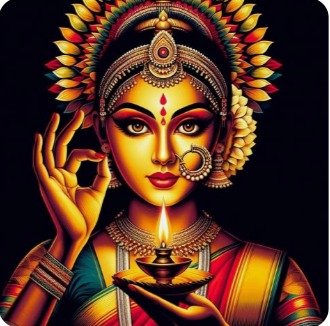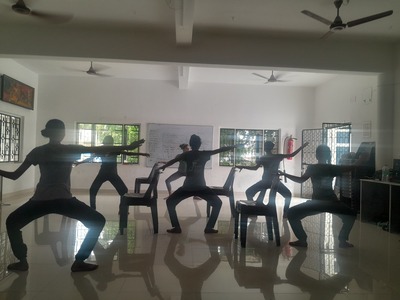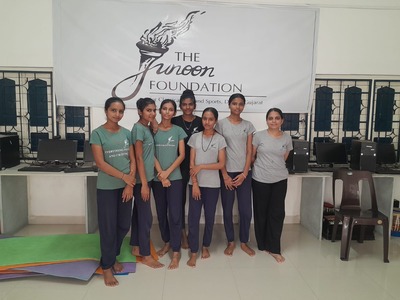
Hema Devika writes an insightful piece on the multiple intelligences that Dance engenders.
Classical Dance in India is an ancient treasure. It finds its home in rich and rooted knowledge systems, cultures, and traditions. As the generations advance and cultures evolve, ancient knowledge should be made available in more feasible ways. To match the current generation, this piece explores elements that aren’t necessarily in a Classical Dance exercise textbook. They are an acquired and varied intelligence from a sustained practice of Dance. Bharatanatyam, specifically, is a holistic experience and a whole volume of extensive knowledge encompassing mental, physical, and psychological wellness.
All practitioners of Classical Dance highlight that being consistent with practice and one’s routine leads to a transformation in one’s life. The physical commitment to one’s practice brings emotional, intellectual, and spiritual evolution. That is the nature of any high-performance activity.
Classical Dance does not only require Dance skills; it requires the potential to identify and coordinate multiple intelligences—mathematical, visual-spatial, musical, kinesthetic, and linguistic. Apart from these, every practitioner learns a set of skills that helps them transform into a better person.
Mathematical intelligence is keeping track of beats and comprehending the patterns in music and also in the Dance piece being practiced. It is crucial to know the music inside out so that even if the music starts at 0.28 seconds, the performance is perfectly coordinated. Understanding music facilitates other intelligences like kinesthetic intelligence and musical intelligence. This intelligence ensures that every beat is danced to, felt, and understood before performing it for the audience.
Kinesthetic intelligence is ensuring the use of and coordination between all bones and muscles and their engagement. Being physically aware of changes in every body part is essential for expression. It helps convey the right emotions to the audience. This intelligence needs plenty of training and hard work. Once the body movements and its capacities are understood, maybe even pushed, a care, love, and respect for the body are evoked. For any practitioner of a Classical Dance form, their body is their ultimate instrument, and they would never intend to harm it in any way. ultimately fostering self-love and confidence. This sounds to me like a very important consequence, as the world today prioritizes mental and bodily health like never before.
Musical intelligence is the ability to perceive and express music. Ragas, rhythms, and taal influence the mood of every individual and every setting they’re played in. In order to effectively convey the emotions of a scene, music must be chosen wisely to ensure accuracy of perception and emotion. A morning raga like Raga Bhairav evokes seriousness and the strength of the sunrise, whereas an evening raga like Raga Yaman emphasizes calmness and devotion. Similarly, different music in different situations corresponds to different feelings called Raga Rasa— the emotional essence (rasa) evoked by every melodic framework (raga). This is why music is a significant tool to guide and tap into the emotions of the audience—‘feel the dancer feels.’ Story, movements, and music in unison make the most impactful performance. A performance worthy of deafening applause and authentic words of affirmation.
Visual-spatial intelligence is the powerful ability to perceive, understand, and then control, but not deceive, factors of a Dance performance. It has a lot to do with emotional capacity and our capacity to evolve in that regard. In the process of practicing the Dance piece, the dancer lives and feels in the shoes of the character they are portraying. Even though the character is negative, cruel, or even not necessarily to their liking, the dancer still has to live the moment and convey the feelings of the character in the best way possible. The dancer strives to understand and empathize with the emotions that are not theirs and interpret their actions and reactions to any situation. As anyone familiar with the original telling of the Ramayana knows, one tends to be devoted to Rama. This could make it difficult to essay the role of Ravana in an act, as personal emotions and beliefs could intervene in fully empathizing with Ravana. It is true that Ravana kidnapped Sita, but a dancer tries to understand why Ravana did so. What made him take such a step? Was it because he wanted to avenge his sister, or did he fall in love with Sita? All dancers strictly practice mindfulness, deep focus, and staying in the moment while performing every piece in order to visualize the thinking and actions of the character they are essaying. The dancer can emulate the character’s actions from their own perspective, as visualizing and understanding is everything, especially with the evolved capacity for these that a repeated and progressive practice of Dance ensures.
Linguistic intelligence is the capability to effectively use the vocabulary of Classical Dance—such as hand gestures, postures, and transitions – to convey a story, a mood, a moment, or a situation without any verbal expression. This makes Dance the language that it is. The magic of Classical Dance lies in finding beauty in the most mundane and engaging the audience therein. Imagine a Dancer dancing a scene of just sitting idly under a tree and playing with flowers. It may seem boring to visualize, but it is beautiful as the focus is shifted to interpreting why she is there, what the flowers indicate, if she is waiting for someone to give these flowers to, if she is smiling, why she is doing so, and so on. A beautiful story is unfolding by identifying the surroundings visually created on stage by the Dancer. This is where we dig deeper into our emotions and the actions that follow those emotions. As the story is being performed, the audience will gradually realize that sitting on a stone, looking at the water flowing through a pair of feet, may also mean that the owner of the feet is lonely and would like someone to talk to. The visual representation speaks louder than if the scene was just narrated along with the act. The audience observes more than just relying on a narrative. Observe how the feet are placed, the surroundings, the character’s facial expressions, and the actions. With all the contemplation that occurs as a result, the audience concludes that the character is lonely. It is not easy but definitely more engaging and exciting because the audience becomes the writers of the scene, exercising the freedom to interpret the scene from their point of view.
The development of these skills develops many other skills, knowledge, and capacities as a direct and indirect consequence. Being a Dancer is an endless cycle of learning, relearning, teaching, and improving because perfection is far. Persistence, grit, and determination are tested in this long journey. A Classical Dancer is not just a Dancer but also a better person mentally, emotionally, and physically—a stable and capable individual. Even if the person does not realize and reflect on themselves, the people around them will definitely notice and appreciate their very mesmerizing transformation, expanding scope, and well-roundedness.




Comments